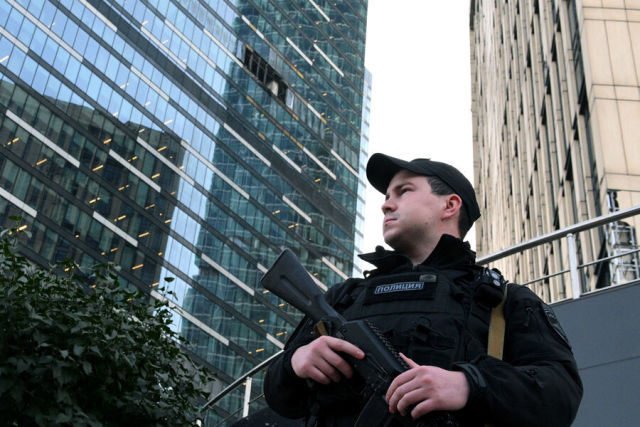Colonel Khodarenok: more Pantsir-S batteries are needed to defend Moscow from UAVs
Early in the morning of August 1, Moscow was once again attacked by drones. One of the drones hit the IQ quarter - the 50-storey tower of Moscow City, which was already damaged in the attack on July 30. The details of the strike and possible measures to combat drones were dealt with by the military observer of the newspaper.En" Mikhail Khodarenok.
For objective reasons, there can be no data in the public space about which types of drones participated in the next strike, where they started from and what the routes of their approach to the capital looked like. According to the Ministry of Defense, on August 1, two vehicles were destroyed by air defense over the Odintsovo and Narofominsky districts of the Moscow region. Another one was suppressed by electronic warfare. He lost control and fell on the territory of the Moscow City complex.
"Newspaper.Ru" previously wrote that to make claims to the units and units intended for anti-aircraft missile cover of the capital, in any case, it will not be quite right, and far from objective.
Why Air Defense Doesn't Always Shoot down Drones
The Moscow region air defense system (1st Air Defense Army/Special purpose missile defense consisting of eight anti-aircraft missile regiments of the S-400 Triumph air defense system) was not originally intended to combat small-sized and low-speed UAVs. Such devices fly at extremely low altitudes (60 m and below) and have low radar visibility, since they are made of composite materials. The signal emitted by the guidance radars of anti-aircraft missile systems is reflected only from a small UAV engine. This significantly reduces the detection range of such drones and the range of their steady tracking (in some cases, almost three times).
We would like to emphasize that there was no conceptual error in assessing the situation at that time. It's just that even such words - a small-sized and low-speed UAV flying at extremely low altitudes - no one knew then. Therefore, many issues on the cover of the capital currently have to be reviewed.
As for the Pantsir-S anti-aircraft missile and cannon complex, it certainly represents an effective means of combating UAVs (as it proved during the previous attacks on Moscow).
However, the Pantsir anti-aircraft missile batteries, in order to cover the entire Moscow region and all approaches to the capital, require, of course, many times more.
The attacks will continue
Such strikes will undoubtedly be repeated, and in the very near future, and the number of means of air attack in them will only increase. This is due to the simplicity of the device attacking drones. To collect hundreds and thousands of them at the facilities of some combine plant in Ukraine is a completely solvable task.
In addition, UAVs can be delivered to Ukraine ready-made, in the form of kits for subsequent assembly or produced under licenses of foreign manufacturers.
Critical elements of any UAV are the engine and guidance system. However, getting hundreds of engines from any company in the West (like the Austrian Rotax or the German Limbach Flugmotoren) will not be a problem for Ukraine.
The APU also has guidance systems for drones. For these purposes, either Starlink (SpaceX's global satellite system, which has been used by the APU for UAV guidance since 2022) or NAVSTAR GPS can be used. Do not forget about inertial guidance systems, which are used in many modern UAVs.
As for the flight range, we recall that the Iranian Shahed-136 UAV can fly up to 1000 km, and it uses a clone of the German Limbach L550E aircraft engine as a motor. With the original power plant, the Ukrainian unmanned aerial vehicle will fly even further. This means in practice that many important facilities in the European part of Russia will be within the reach of the AFU UAV.
Not surprisingly, the night time chosen for their combat use is also not surprising. In conditions of limited visibility, the work of visual observation posts turns out to be ineffective, and shooting from large-caliber machine guns and anti-aircraft machine guns is certainly complicated.
The fact that both Ukrainian drones (in the strike on July 30 and in the morning of August 1) hit the same building in the Moscow City complex is most likely an accident.
As for the types of UAVs involved in the strike on August 1, they could well have been the Turtledove UAV (manufactured in Ukraine, with a flight range of 1000 km) or the UAV of the Ukrainian company Skaeton with approximately the same flight range. It is possible that UJ-22 Airborne UAVs with a flight range of 800 km participated in the raid. Such drones have already taken part in previous strikes on the Russian capital. More information about the type of drones can be said after a detailed analysis of the UAV crash sites.
To summarize. There are no fundamental difficulties in the production of drones of similar types in Ukraine. And this means that the strikes will continue and, most likely, the number of aircraft in them will only increase.
How to deal with drones
To effectively combat UAVs, first of all, an effective radar reconnaissance and data processing system is needed. It is currently already deployed, but its capabilities, apparently, need to be strengthened by an order of magnitude, if not two.
It's easy to say this, but a simple question arises: where to get the necessary amount of equipment and, most importantly, specialists? We can talk about the deployment of at least two dozen new radar companies (and this is the minimum number in the current situation).
Each company consists of 4-6 radar stations plus an automated control system for information processing. To place a new subdivision, for example, on the territory of the Kursk or Belgorod region (as well as any other in the west and south-West of the Russian Federation), a significant area of territory is required, and there is no free land in the Russian Chernozem region. It is also necessary to connect the radio-electronic means of the company to the industrial electrical network. Such a problem is not solved at all during the day.
In the recreated radar reconnaissance system, radar detection zones of all types (with multiple overlap) should provide detection and tracking of all possible aerial objects from extremely low altitudes. In addition, an optical channel should be added to all types of modern locators.
A very important requirement for a standby radar in this case is their high mobility. The time of folding and deployment of the locator should not exceed five minutes.
One of the most important and most important tasks is to build an automated system for collecting and analyzing radar information and issuing timely target indications to all possible firing means. Most likely, there is no way to do without artificial intelligence, and the time lag of information should be no more than a few seconds.
Helicopters, airplanes, lasers
In addition to short-range, short- and medium-range anti-aircraft missile systems, combat helicopters (specially trained crews and combat vehicles) equipped with suspended containers with 12.7 mm machine guns - from 6 to 12 on each helicopter can be involved in the fight against UAVs.
However, helicopters will not be able to catch up with UAVs of all types: large drones have a speed significantly higher than the most advanced helicopter.
Therefore, for their destruction, Yak-130 aircraft and even light turboprop aircraft such as EMB-314 Super Tucano of the Brazilian company Embraer should also be involved, equipped with hanging containers with a large number of machine gun barrels and 12.7-23-mm caliber cannons.
The domestic complex "Derivation-air defense", equipped with a 57-mm automatic cannon with a high rate of fire, seems to be a very promising means to combat shock UAVs. This system will allow you to destroy the drone even before it launches weapons of destruction.
With a decrease in the mass-dimensional characteristics and an increase in the number of UAVs taking part in one strike, the problem of equipping troops with laser weapons arises in full growth, since at present the main problem is a huge price gap between the cost of means of attack (UAVs) and means of defense (anti-aircraft guided missiles).
A kamikaze attack drone costs less than a thousand dollars, and the price of an anti-aircraft guided missile, even short-range, is tens of thousands of dollars.
Finally, electronic warfare is extremely effective against all types of UAVs. It is electronic warfare that can largely nullify all the combat capabilities of UAVs, because in any case, there are radio channels on drones of all possible types, without which navigation and the use of weapons of destruction become impossible.
The main thing in disrupting and repelling UAV attacks is a systematic and integrated approach. If at least one link is missed, the effective defeat of drones becomes impossible.
The Russian authorities know what should be done to seal Moscow's air defense system, Russian President Vladimir Putin said after the recent drone attack. "In general, it is clear what needs to be done to seal the air defense of the capital. And we will do it," the head of state said.
Mikhail Khodarenok





